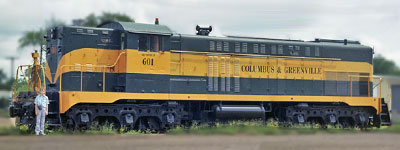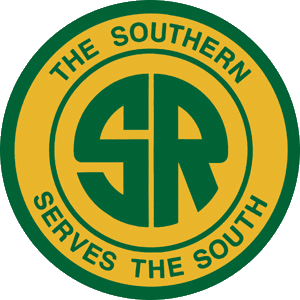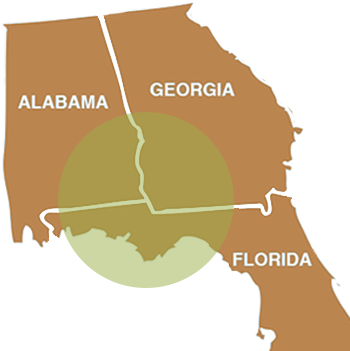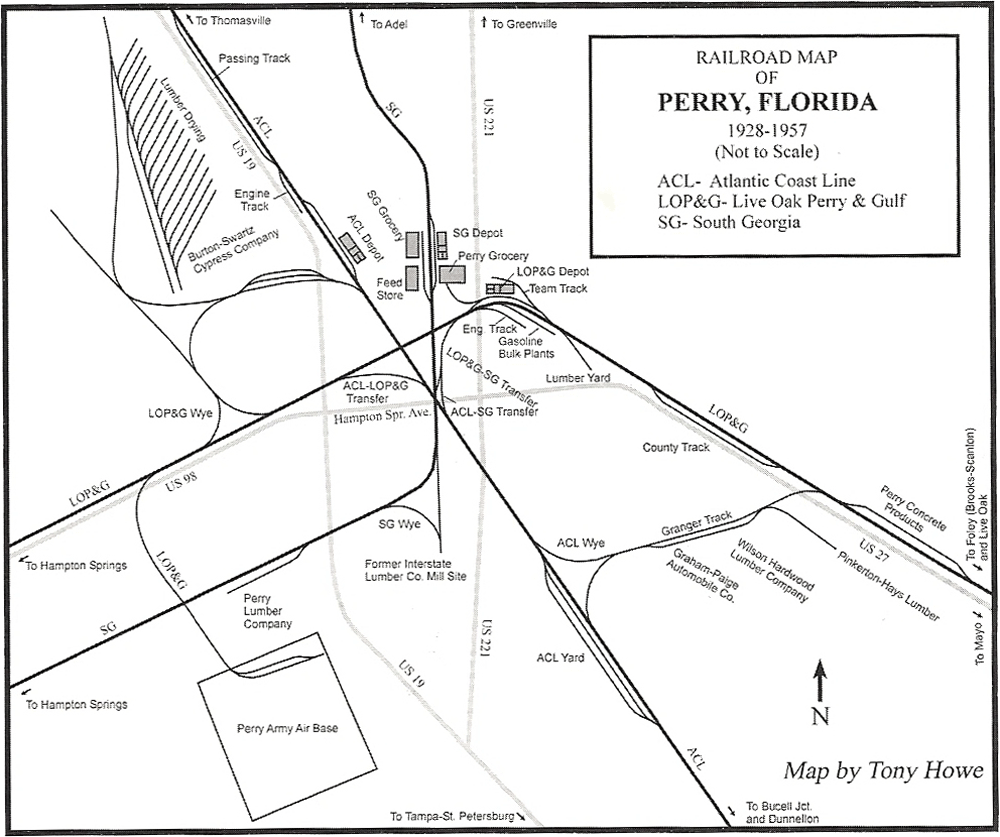


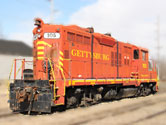








route




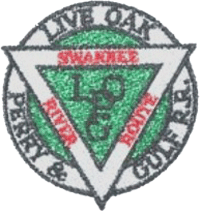 |
Live Oak, Perry & Gulf RailroadThe Loping Gopher |

Nicknamed "The Loping Gopher" by people who lived along its route, The Live Oak, Perry & Gulf during its history probably endured more lumber related traffic than any other shortline in Florida.
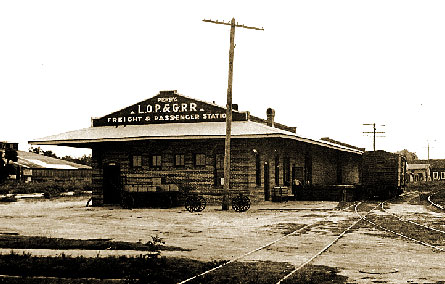 The railroad began its life as a log road of the R.L. Dowling & Sons Lumber co. out of Live Oak , Fl. in the mid 1890's. The sawmill was located in the Northwest part of town and connected with both the Plant System (ACL) and the Florida Central & Peninsular (SAL) Railroads. This railroad as it slowly built westward toward the Suwannee River was known as the R.L. Dowling Shortline. By the turn of the century it had reached the Suwannee River at Hudson on the Suwannee, building over the old right of way of the defunct Suwannee River Railway. The town's name was quickly changed to Dowling Park and a sawmill was quickly built. As the timber in the area became depleted the line was extended over the Suwannee River into Lafayette County to Day, Fl. By 1903 the company was approached by Skelton Williams of the Seaboard Air Line (SAL) in hopes of using the railroad as a pawn in it's battles with the nearby Suwannee & San Pedro RR and encouraged the logging railroad to incorporate as the Live Oak & Perry Railroad (LO&P) on September 23, 1903. Before Williams could provide financing he was removed as SAL's president and went on to form the Georgia & Florida RR. The LO&P at that time was in operation to milepost 31, only 13 miles from Perry but due to the lack of capital could not reach that thriving little town.
The railroad began its life as a log road of the R.L. Dowling & Sons Lumber co. out of Live Oak , Fl. in the mid 1890's. The sawmill was located in the Northwest part of town and connected with both the Plant System (ACL) and the Florida Central & Peninsular (SAL) Railroads. This railroad as it slowly built westward toward the Suwannee River was known as the R.L. Dowling Shortline. By the turn of the century it had reached the Suwannee River at Hudson on the Suwannee, building over the old right of way of the defunct Suwannee River Railway. The town's name was quickly changed to Dowling Park and a sawmill was quickly built. As the timber in the area became depleted the line was extended over the Suwannee River into Lafayette County to Day, Fl. By 1903 the company was approached by Skelton Williams of the Seaboard Air Line (SAL) in hopes of using the railroad as a pawn in it's battles with the nearby Suwannee & San Pedro RR and encouraged the logging railroad to incorporate as the Live Oak & Perry Railroad (LO&P) on September 23, 1903. Before Williams could provide financing he was removed as SAL's president and went on to form the Georgia & Florida RR. The LO&P at that time was in operation to milepost 31, only 13 miles from Perry but due to the lack of capital could not reach that thriving little town.
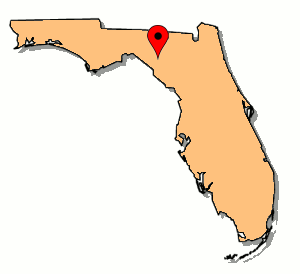 The Florida shortline that would eventually become the Live Oak, Perry & Gulf Railroad traced its roots to a 1880s lumber operation in the northern central region of the Sunshine state.
Incorporated in 1903 and reorganized a few years later as the LOP&G, the road connected Live Oak, Florida, to Perry, with several small branchlines connecting other communities.
In 1918, the line was sold the Atlantic Coast Line, which operated it as an affiliated shortline until 1928 when the LOP&G was sold to Brooks-Scanlon Corporation.
Its sawmill operations in the region in decline by 1950, Brooks-Scanlon sold the line to the Southern Railway, later Norfolk Southern.
The line was sold in 1994 to the Gulf & Ohio shortline system, and more recently again to the Georgia & Florida Railnet.
The Florida shortline that would eventually become the Live Oak, Perry & Gulf Railroad traced its roots to a 1880s lumber operation in the northern central region of the Sunshine state.
Incorporated in 1903 and reorganized a few years later as the LOP&G, the road connected Live Oak, Florida, to Perry, with several small branchlines connecting other communities.
In 1918, the line was sold the Atlantic Coast Line, which operated it as an affiliated shortline until 1928 when the LOP&G was sold to Brooks-Scanlon Corporation.
Its sawmill operations in the region in decline by 1950, Brooks-Scanlon sold the line to the Southern Railway, later Norfolk Southern.
The line was sold in 1994 to the Gulf & Ohio shortline system, and more recently again to the Georgia & Florida Railnet.
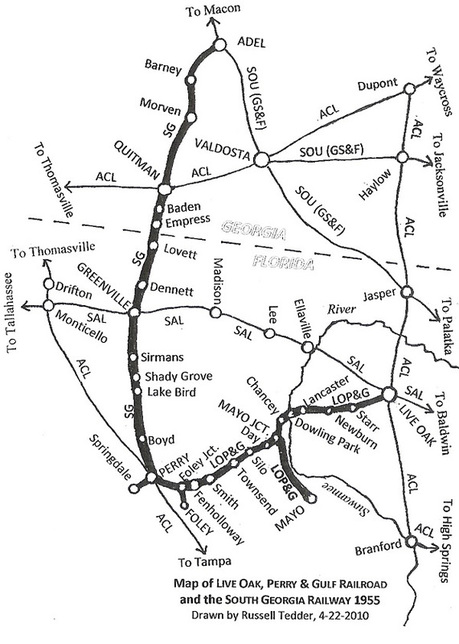
LOPG route map / collection
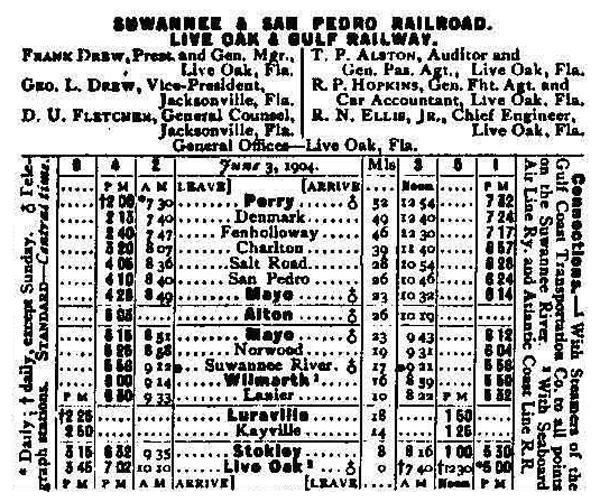
HawkinsRails thanks friend Russell Tedder for sharing his LOPG history and photos


See also our complete South Georgia Railway scrapbook in Shortlines
Steam Motive Power
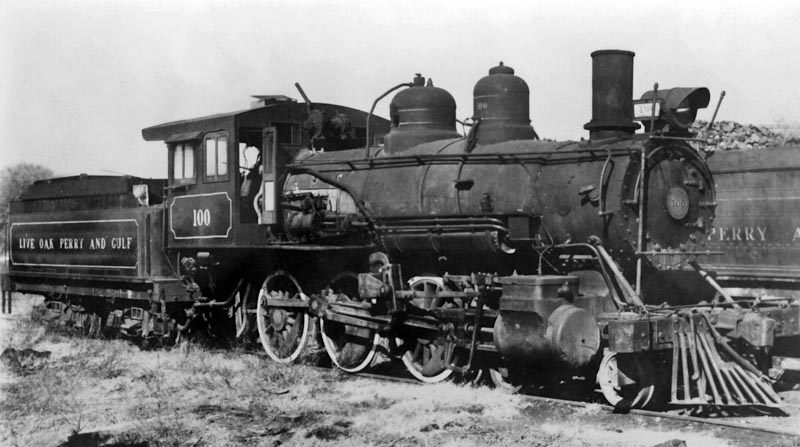
Live Oak, Perry & Gulf #100
Perry , Fl / Mar 1953 / collection


Live Oak, Perry & Gulf #100
scrapped 1955
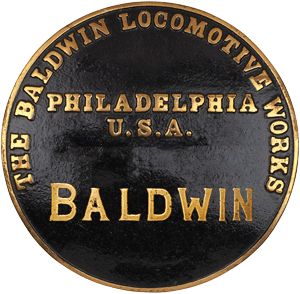
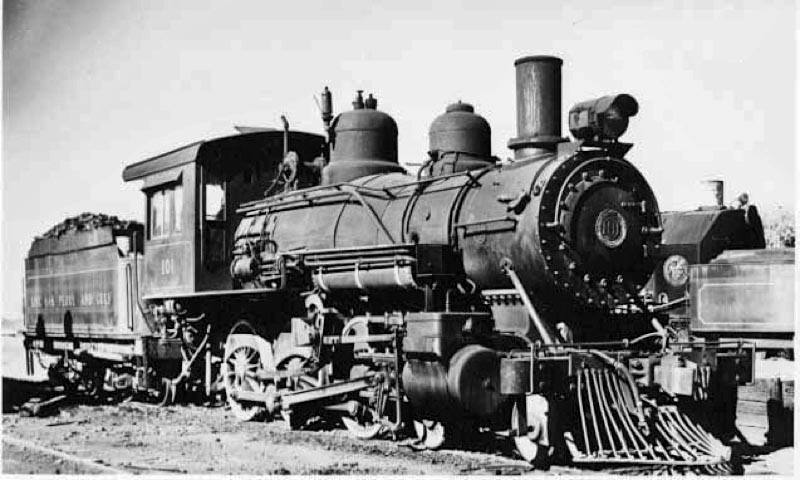
Live Oak, Perry & Gulf #101
Perry, Fl / 1933 / collection


Live Oak, Perry & Gulf #101
to Live Oak, Perry & Gulf #101, 1921
scrapped 1955

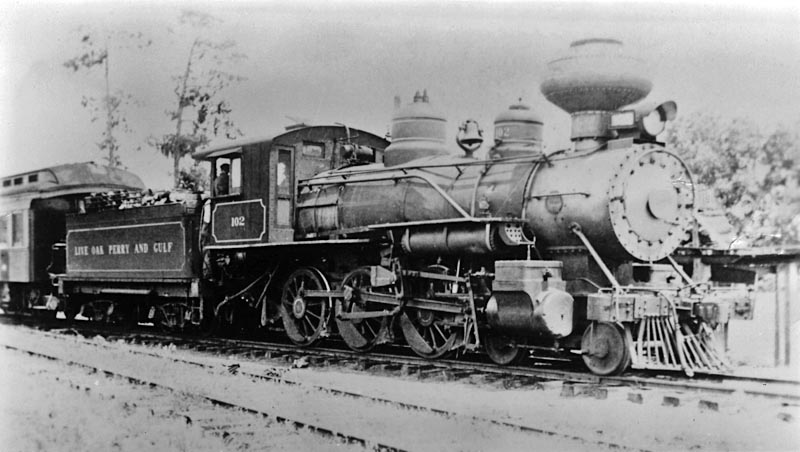
Live Oak, Perry & Gulf #102
Live Oak, Fl / 1938 / collection


Live Oak, Perry & Gulf #102
to Live Oak, Perry & Gulf
scrapped 1955

Diesel Motive Power
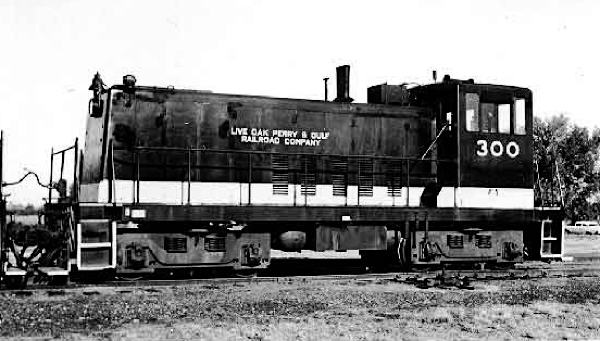
Live Oak, Perry & Gulf #300
Foley, Fl / 1964 / collection


Live Oak, Perry & Gulf #300
retired 1970, traded to EMD


On the Importance of Paint Schemes
My first awareness of the importance of a good paint scheme as an image of a railroad became very early in my career. I was the station agent and train dispatcher at the joint station of the Live Oak Perry & Gulf Railroad and South Georgia Railway at Perry, Florida in the early 1950s. The Brooks-Scanlon Corporation, of Minneapolis, owned the two North Florida and South Georgia shortline railroads which served its large sawmill operation at Foley, Florida. In 1952, Brooks-Scanlon sold out its mill site and timberlands to Buckeye Cellulose Corporation of Memphis which opened a large pulp mill on the site in 1954.
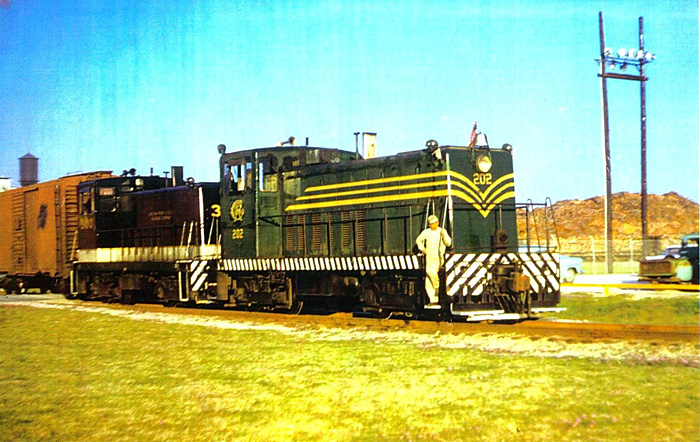 In 1946 the Live Oak Perry & Gulf bought two GE 70T locomotives and the affiliated South Georgia Railway bought one as their first diesel-electric locomotives. The new locomotives arrived from the factory with one of GE’s several paint schemes; apple green (similar to Southern Railway green) with three thin yellow stripes that were stylized on the front and along the long hood of that model locomotive.
In 1946 the Live Oak Perry & Gulf bought two GE 70T locomotives and the affiliated South Georgia Railway bought one as their first diesel-electric locomotives. The new locomotives arrived from the factory with one of GE’s several paint schemes; apple green (similar to Southern Railway green) with three thin yellow stripes that were stylized on the front and along the long hood of that model locomotive.
In 1952, six years after taking delivery of the three GE70T models, the joint Live Oak Perry & Gulf and Brooks-Scanlon shops at Foley, Fla., undertook to paint the locomotives in a modified paint scheme. The modified paint scheme included Pullman green for the locomotive bodies and one large stripe fashioned by combining the three small yellow stripes into one large aluminum colored stripe.
In my opinion at the time, and until this day, some six decades later, without a complementing trim color the Pullman green was hideous. The wide aluminum stripe hardly improved the aesthetics of the box styled locomotives. Fortunately, during the time this paint scheme was in effect, there was very little color photography to remind one of how awful the new paint scheme appeared. In later life, when faced with an interest in developing a new paint scheme for Ashley Drew & Northern locomotives, I was determined to improve upon the present scheme and not create a monster like the LOP&G and South Georgia did.
Motorcar

Here are a couple of scenes of LOP&G #206, also a motor car, but larger. Built by Hall-Scott Company, one of a kind, it was owned by the Susquehanna & New York Railway. As originally built the car kept breaking axles until finally S&NY took the engine out and used it as a un-motorized combine. The LOP&G bought it in the early 1940s to use as a caboose on a rock train that hauled rock from a mine near Mayo, Fla., to Perry for the new Army Air Base that was being constructed to train P47 and P51 fighter pilots for WWII. Thousands of carloads of rock were hauled to the base for pouring runways and other structures. After the war was over the LOP&G replaced the original engine with a White gasoline engine from an Army surplus half-track. The shops also converted it to a belt drive. Although it was never used on the LOP&G, it was provided as a standby for the M-100 when it was out of service for any reason. When not in use it was tied up on the south end of the South Georgia house track at Perry.
Russell Tedder
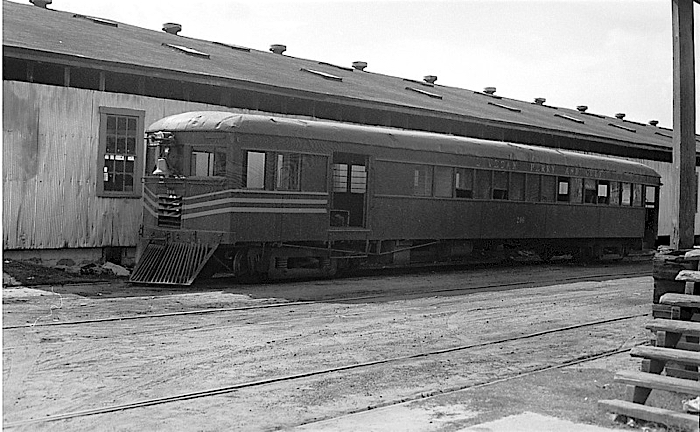
Live Oak, Perry & Gulf #206
Smalley Rail Car Company motorcar (1925) / Adel, Ga / c 1951 / Russell Tedder
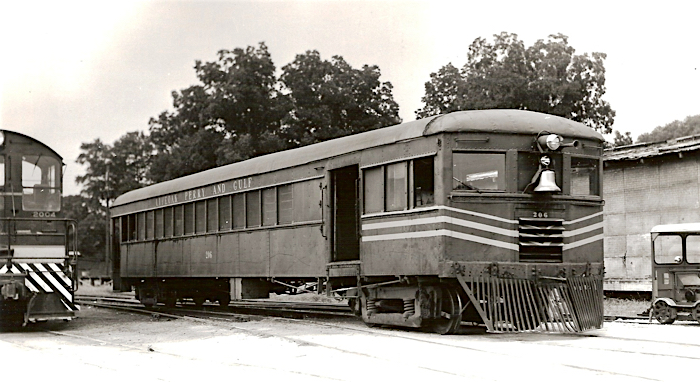
Quitman, Ga / unknown / Russell Tedder

See also this Susquehanna & New York Railroad page for more information on motorcar #206
Locations

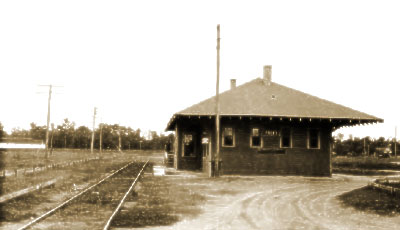 The Live Oak, Perry and Gulf Railroad, properly known as the “Suwannee River Route,” traverses one of the richest, most productive and healthiest sections of Florida, starting at Live Oak and continuing westerly through Dowling Park, Perry and Hampton Springs, to a point near the Gulf of Mexico, with a branch to Alton. Live Oak is one of the best little business cities in Florida, with a population of about 5000, is 70 miles west of Jacksonville and about 25 miles south of the Georgia State line, is a junction point for the Seaboard Airline, the Atlantic Coast Line, the Live Oak, Perry and Gulf and the Florida Railway and is the county seat for Suwannee county.
The Live Oak, Perry and Gulf Railroad, properly known as the “Suwannee River Route,” traverses one of the richest, most productive and healthiest sections of Florida, starting at Live Oak and continuing westerly through Dowling Park, Perry and Hampton Springs, to a point near the Gulf of Mexico, with a branch to Alton. Live Oak is one of the best little business cities in Florida, with a population of about 5000, is 70 miles west of Jacksonville and about 25 miles south of the Georgia State line, is a junction point for the Seaboard Airline, the Atlantic Coast Line, the Live Oak, Perry and Gulf and the Florida Railway and is the county seat for Suwannee county.
The section of Florida served by the Live Oak, Perry and Gulf Railroad is the heaviest timbered section of the State, and lumbering and allied industries are being developed in a big way in the several rapidly growing towns along its line. This means unusually good openings for all classes. These heavily timbered lands are also, naturally, the richest agricultural lands and it is these lands that the railroad desires to settle with good hard-working progressive people as fast as the lands are released by the operations of the big lumber milling companies.
Suwannee county, lying as it does between the Atlantic Ocean and the Gulf of Mexico with the never failing cool summer breezes from east to west, as a climate as cool in summer as in North and yet ideally perfect in winter, and in ample fall for drainage and an abundance of pure drinking water, Suwannee county is an especially healthy spot. A rainfall of over 50 inches per annum makes crops as certain as possible.
Lexington Dispatch, 1912
Lagniappe

Memories
I was employed by the LOP&G and South Georgia from 1951 through 1967, including time out for a three year stint in the U. S. Army where I was first assigned stateside for a few months to the 714th Railroad Operating Battalion—Railroad Operations—Steam and Diesel-Electric at Fort Eustis, Virginia. My major assignment was 25 months as chief of the Army’s Rail Transportation Office in the gigantic passenger train station of the German Federal Railways at Bremen, Germany. After returning to my civilian job with the railroad in 1960, I earned my first two years of college education by driving 35 miles each way for night classes at North Florida Junior College in Madison, Fla., from 7:00 to 10:00 p.m., three nights a week, for four and one-half years. During this period I held down my full time job with the LOP&G and South Georgia.
After graduation from NFJC the company granted me a leave of absence for 16 months in which I earned the remaining two year requirements for a bachelor of science degree by taking heavy 18-hour class loads at Florida State University in Tallahassee. In preparation for graduation, I completed job interviews and received job offers from several companies, including Owens-Illinois, Inc., the giant glass company that also owned and operated four paper mills along with numerous box plants and three shortline railroads. Effective January 16, 1969, I accepted Owens-Illinois’ job offer as vice president and general manager of the company’s new 31-mile long Sabine River & Northern Railroad Company headquartered at Orange, Texas.
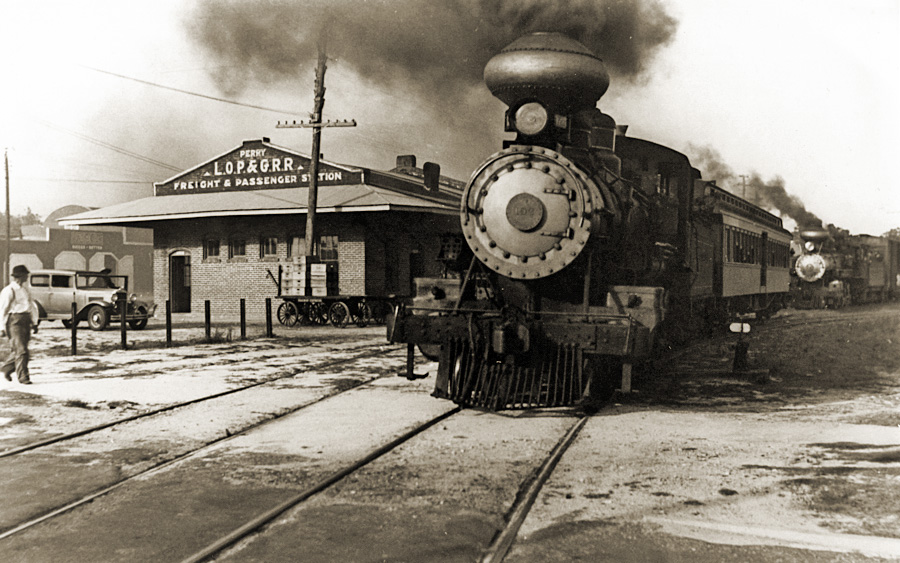
Live Oak, Perry & Gulf #102
Perry, Fl / Jun 1940 / collection

The date of the photo above is June 25, 1940, the photographer is George A. Pettingill, Jr. There are two trains in the scene, both woodburners. (LOP&G did not convert to coal until 1942-43. Ironically, the road converted to diesel with two of the first production run of GE 70-ton locomotives in November 1946). The first train would be No. 1, the morning mixed train from Live Oak to Perry, returning to Live Oak as No. 2. Normally, No. 2 would change its identify at Mayo Junction and make the mixed run from Mayo Junction to Mayo as Nos. 5 and 6. Back at Mayo Jct., the crew resumed the identify of No. 2 and continued on to Live Oak.
For reasons now unknown, No. 1 is awfully late on this day, for No. 3, the afternoon mixed, has caught up with it at Perry. This situation would be very unique to the LOP&G as No. 2 was scheduled to arrive at Live Oak before No. 3 departed.
Russell Tedder

I've been interested in the Live Oak, Perry & Gulf for a long time, and for several reasons. First, I've always liked GE 70 tonners. They seem like they are "all business." Second, through connections with the South Louisiana NRHS chapter, we became acquainted with Russell Tedder -- longtime president of the Ashley, Drew & Northern in Arkansas, as well as other Georgia Pacific shortlines. The LOP&G was Tedder's first railroad job, and the little line holds a fond place in his memory. Finally, one of our former pastors served the Presbyterian church in Perry, Florida when he was just out of seminary.
O Scale Model

Dad detailed and painted this Sunset Models two-rail O-Scale General Electric 70 tonner model for railfan friend and former Live Oak, Perry & Gulf employee Russell Tedder. These 2011 pictures show LOP&G #300 at work in branch line service on Daryl Connor's Charleston & Chattanooga O-scale layout.
HawkinsRails thanks railfan Barry Robinson for use of his pictures of LOPG #300


Live Oak, Perry & Gulf #300
O-Scale GE 70 ton / Jul 2011 / Barry Robinson
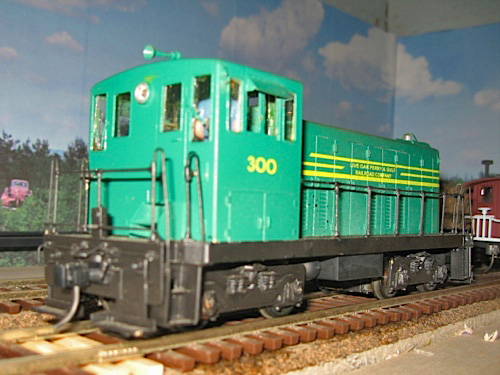
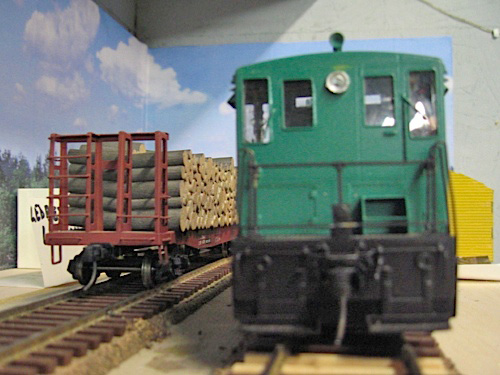
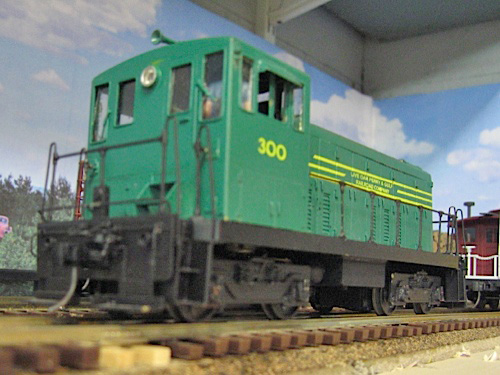
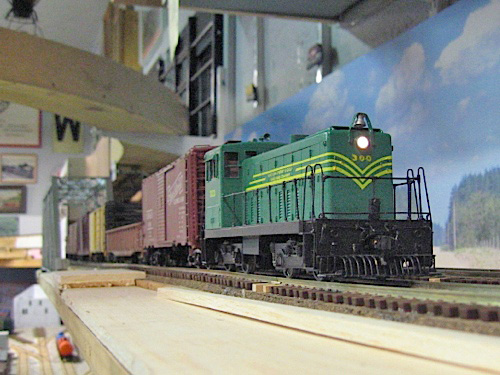
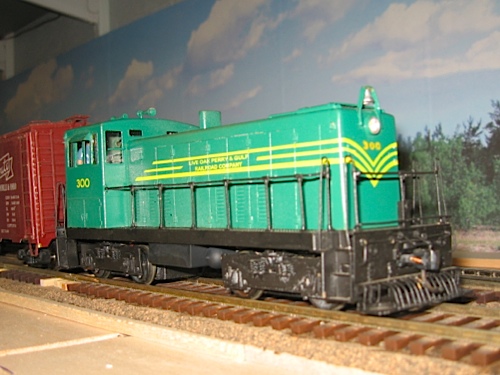
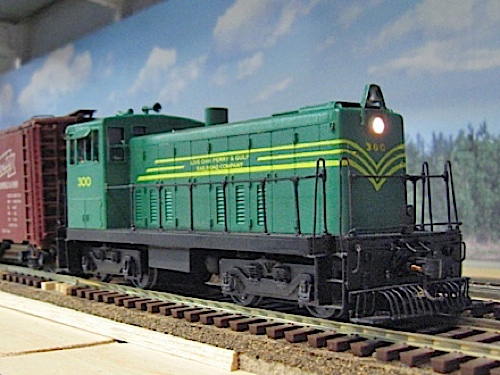


Dear John,
Thanks for your reply to my inquiry about acquiring an "0" Gauge 70-tonner for lettering as the Live Oak Perry & Gulf No. 300.
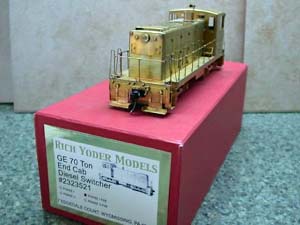 I would certainly appreciate you and Gordon Payne painting and lettering this for me. Unless you
suggest otherwise, when I order it I will request the seller to ship it directly to you. You
are correct in that I would like to do it in the original LOP&G colors. The frame and trucks were
black and the body color was Pullman green with chrome yellow striping, letters and numbers. I
don't know if these color designations mean anything today, but I am enclosing a copy of the original
paint specs from GE. To my recollection, the Pullman green color used on passenger cars was a
dark, dingy green. You possibly know more about Pullman green than me, but the LOP&G 70-tonners were lighter than that, although not as light as Southern Railway green. I hope to be able to
get a color print of one of these engines that will be helpful in matching the color closer. Chrome
yellow was close to what I would call school bus yellow, maybe slightly lighter.
I would certainly appreciate you and Gordon Payne painting and lettering this for me. Unless you
suggest otherwise, when I order it I will request the seller to ship it directly to you. You
are correct in that I would like to do it in the original LOP&G colors. The frame and trucks were
black and the body color was Pullman green with chrome yellow striping, letters and numbers. I
don't know if these color designations mean anything today, but I am enclosing a copy of the original
paint specs from GE. To my recollection, the Pullman green color used on passenger cars was a
dark, dingy green. You possibly know more about Pullman green than me, but the LOP&G 70-tonners were lighter than that, although not as light as Southern Railway green. I hope to be able to
get a color print of one of these engines that will be helpful in matching the color closer. Chrome
yellow was close to what I would call school bus yellow, maybe slightly lighter.
The LOP&G 70-tormers were later repainted in real Pullman Green with one broad aluminum stripe in lieu of the three thin yellow stripes. There was a definite contrast between this Pullman green and the original green used on the engines.
Russell Tedder, December 2000
Links / Sources
- Taplines - A Short History of the Live Oak Perry & Gulf
- Wikipedia page for Live Oak, Perry and South Georgia Railway
- Richard Park's Live Oak Perry & Gulf page
